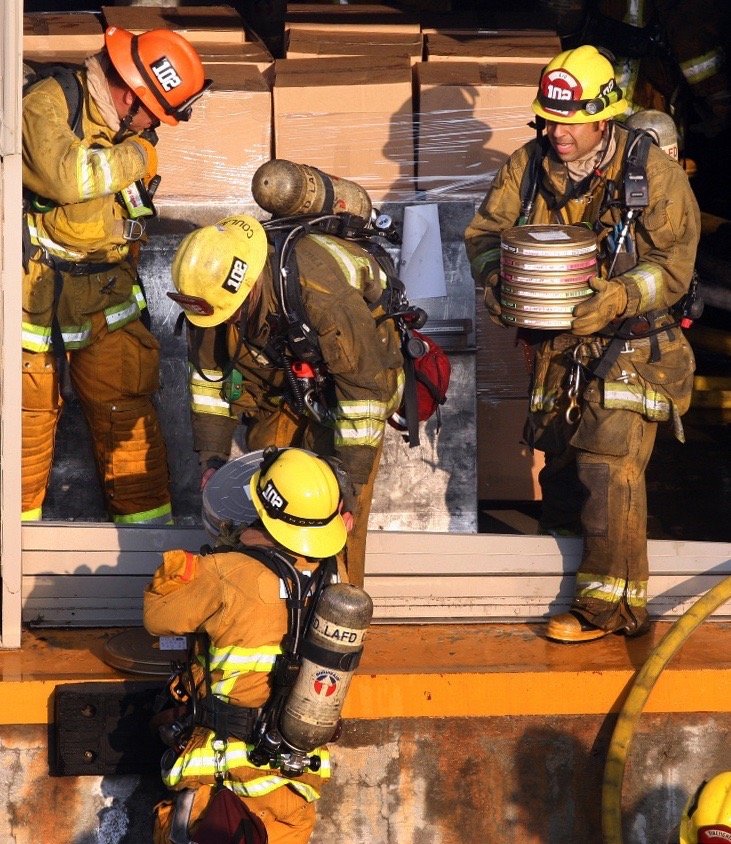The Cover-Up of the Biggest Disaster in Music History

A vault said to contain a half-million song masters of the Universal Music Group went up in flames 11 years ago. Musicians are just now finding out about it.
A fire swept a Hollywood backlot on Sunday, June 1, 2008. As hundreds of firefighters battled the intense heat, Randy Aronson, director of vault operations for the Universal Music Group, feared that the blaze would penetrate a 2,400 square feet vault containing the original music possessed by the world’s largest music company.
Flames engulfed the vault. Aronson’s worst fears were realized.
Here is a three-minute CBS News report that was broadcast June 15, 2019, via YouTube:
In a confidential report issued to NBCUniversal (which owned the lot) and to insurance companies in 2009, UMG admitted that “an estimated 500K song titles” were lost.
However, UMG initially claimed that only 22 original masters made by five artists were lost in the blaze, according to internal memos obtained by the New York Times. Apparently, there was (and continues to be) legal wrangling over an ownership distinction between the master tape as a physical object as opposed to the sound recording content (intellectual property) contained on the master.
Numerous artists like Bryan Adams, Adam Duritz of the Counting Crows and notably Richard Carpenter, aspiring to release compilations or anniversary reissues, were puzzled when their requests for master tapes were ignored or went unfulfilled.
Arnaud de Puyfontaine, head of UMG’s parent company Vivendi, scoffed at rumors about the fire’s impact, calling industry whispers “a lot of noise.”
That noise would grow deafening: On June 11, 2019, the New York Times Magazine published a groundbreaking expose on the fire, its aftermath and consequences, opening the door on what’s being called the biggest disaster in music history.

The day after the article was published, Sheryl Crow tweeted, “…shame on those involved in the cover-up. Massive fire at UMG 11 years ago, and we’re just hearing about it now?”
What is a Song Master?
A master is an original recording from which all other subsequent recordings are derived. “Sonically, masters can be stunning in their capturing an event in time,” remarked Adam Block of Sony Music. “Every copy thereafter is a sonic step away.” Masters often contain session notes and chatter.
Very simply, “a master of a recording is that recording. It is the thing itself.” Analogies abound: the difference between a painting and a photograph of that painting. Or like a chef having to use pre-cooked food.

Aside from the more recognizable contemporary artists, the fire destroyed the masters of rare blues and jazz treasures:
- Decca artists such as Louie Armstrong, Duke Ellington, Al Jolson, Bing Crosby, Ella Fitzgerald, Judy Garland and Billie Holiday.
- The Chess Records masters of Chuck Berry plus notable blues artists such as Muddy Waters, Howlin’ Wolf, Willie Dixon, John Lee Hooker and Little Walter.
- Masters of the Impulse jazz label luminaries John Coltrane, Count Basie, Dizzy Gillespie, Sonny Rollins and Charles Mingus.
- The fire destroyed all of Buddy Holly’s masters, as well as such iconic recordings as Bill Haley’s “Rock Around the Clock,” “Rocket 88,” “Louie Louie” and “People Get Ready.”
- A laundry-list of artists whose record labels had migrated to UMG prior to 2008 (Sheryl Crow included), notably A&M and Geffen.

The artists affected by the fire and UMG’s cover-up are seeking their day in court. The “class” of plaintiffs include the rock band Soundgarden, singer and guitarist Steve Earle, the estate of rapper Tupac Shakur and the former wife of Tom Petty, who’s involved in a separate dispute over Petty’s estate. Here is a short (one minute, 48 seconds) news dispatch of a class-action lawsuit by Billboard News via YouTube:
Responding to UMG’s promise to artists that its “dedicated global team” will reclaim every asset lost in the fire, Ed McPherson, attorney for one of the plaintiffs, had this to say:
Well, isn’t that great! After 11 years of assuring artists that nothing was lost in the fire, UMG is actually conducting an investigation…Perhaps this wouldn’t be such a daunting endeavor if 1) UMG had created an actual inventory of the masters they were storing, and 2) UMG had enlisted its ‘dedicated global team’ 11 years ago…
Ed McPherson
Coda
Randy Aronson was let go by UMG in January 2016. No reason was given. He loves the music business but can’t seem to find traction with the few remaining record companies. “The company knew there would be shock and outrage if people found out the real story” he says. “It’s a secret I’m ashamed to be a part of.”
In September 2017 Aronson and his wife sold their house, bought a trailer and moved to the Northern California coast. He recently got a job at a non-profit that serves low-income residents.
















































































































